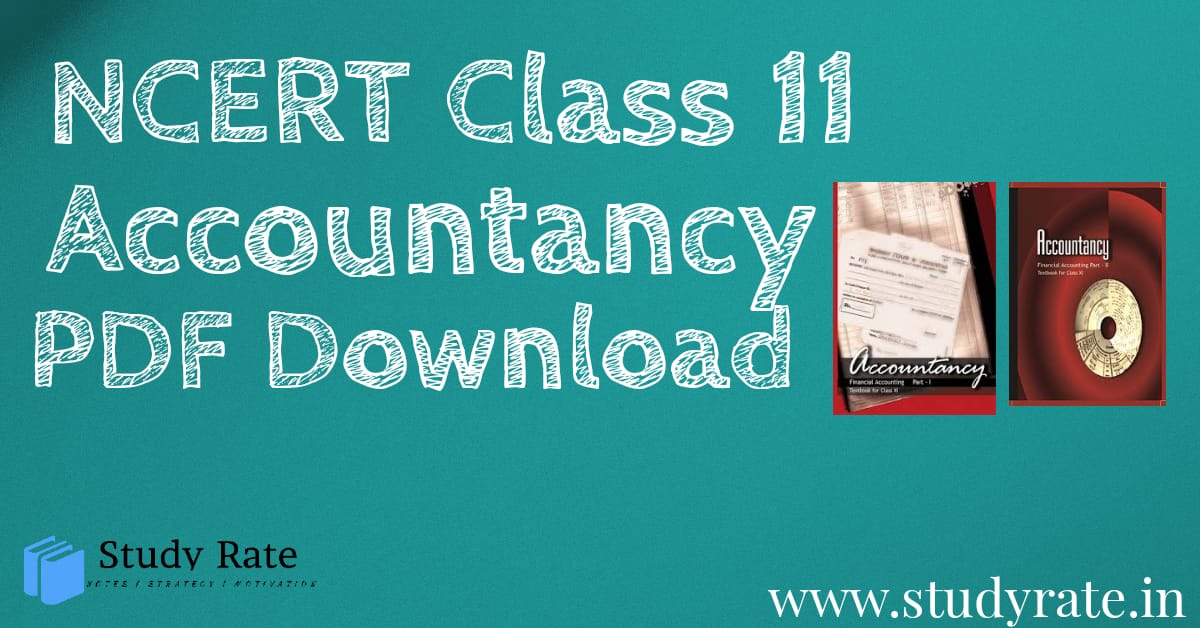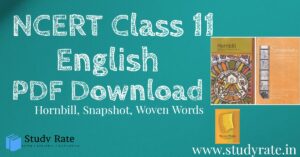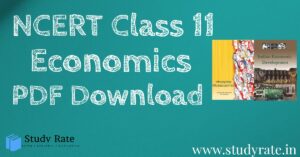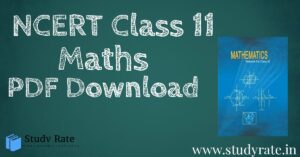The National Council of Educational Research and Training (NCERT) is an autonomous body entrusted with the responsibility of publishing textbooks such as the NCERT book for Class 11 Accountancy. For the CBSE examination, students can adhere to the NCERT book of Accountancy Class 11 as it elucidates on all topics and concepts included in the CBSE syllabus. All necessary topics are also systematically covered in this book.
Join our Telegram Channel, there you will get various e-books for CBSE 2024 Boards exams for Class 9th, 10th, 11th, and 12th.
NCERT Books Class 11 Accountancy: The National Council of Educational Research and Training (NCERT) publishes Accountancy textbooks for Class 11. The NCERT Class 11th Accountancy textbooks are well known for it’s updated and thoroughly revised syllabus. The NCERT Accountancy Books are based on the latest exam pattern and CBSE syllabus.
NCERT keeps on updating the Accountancy books with the help of the latest question papers of each year. The Class 11 Accountancy books of NCERT are very well known for its presentation. The use of NCERT Books Class 11 Accountancy is not only suitable for studying the regular syllabus of various boards but it can also be useful for the candidates appearing for various competitive exams, Engineering Entrance Exams, and Olympiads.
NCERT Books Class 11 Accountancy PDF Download
| Class | 11th |
| Board | CBSE |
| Book | NCERT |
| Subject | Accountancy |
| Medium | English / Hindi |
| Study Materials | Free Study Materials Available |
| NCERT Maths | NCERT Accountancy Book Class 11 PDF Download |
NCERT Class 11 Accountancy Books in English
NCERT Solutions for Class 11 Accountancy Part 1 Financial Accounting
- Chapter 1 Introduction to Accounting
- Chapter 2 Theory Base of Accounting
- Chapter 3 Recording of Transactions – I
- Chapter 4 Recording of Transactions – II
- Chapter 5 Bank Reconciliation Statement
- Chapter 6 Trial Balance and Rectification of Errors
- Chapter 7 Depreciation, Provisions and Reserves
- Chapter 8 Bills of Exchange
Accountancy: Financial Accounting Part 2
- Financial Statements – I
- Financial Statements -II
- Accounts from Incomplete Records
- Accounting for Not-for-Profit Organisation
- Applications of Computers in Accounting
- Computerised Accounting System
- Structuring Database for Accounting
- Accounting System Using Database Management System
NCERT Accountancy Books for Class 11 Part-1 – PDF Download
NCERT Accountancy Books for Class 11 Part-2 – PDF Download
NCERT Books for Class 11 Accountancy – Hindi Medium
NCERT Solutions for Class 11 Accountancy Part 1 Financial Accounting
- Chapter 1 Introduction to Accounting
- Chapter 2 Theory Base of Accounting
- Chapter 3 Recording of Transactions – I
- Chapter 4 Recording of Transactions – II
- Chapter 5 Bank Reconciliation Statement
- Chapter 6 Trial Balance and Rectification of Errors
- Chapter 7 Depreciation, Provisions and Reserves
- Chapter 8 Bills of Exchange
Accountancy: Financial Accounting Part 2
- Financial Statements – I
- Financial Statements
- Accounts from Incomplete Records
- Accounting for Not-for-Profit Organisation
- Applications of Computers in Accounting
- Computerised Accounting System
- Structuring Database for Accounting
- Accounting System Using Database Management System
NCERT Accountancy Books for Class 11 Part-1 – PDF Download (Hindi Medium)
NCERT Accountancy Books for Class 11 Part-2 – PDF Download (Hindi Medium)
Why NCERT Class 11 Accountancy Book is Important
The importance of NCERT Books for Class 11 Accountancy are listed below:
- NCERT Books for Class 11 Accountancy covers all the important topics and concepts that are prescribed in NCERT Curriculum and CBSE Class 11 Accountancy Syllabus.
- All the topics and concepts are explained in easily understandable language.
- Helps to build strong foundation on all the concepts.
- If students are clear with questions and answers present in NCERT books then they can easily score good marks in the examination.
- Students can easily prepare for their board exams.
- Most of the questions asked in the board examination are completely from the NCERT Solutions.
- Helps to understand the basic concepts clearly.
- Helps in preparation of scholarship exams like NTSE, Olympiad as most of the scholarship exams syllabus is same as NCERT Syllabus.
- Students who are aiming to secure prestigious Government Jobs such as UPSC, FCI must have good knowledge of NCERT Books.
We hope that this detailed article on NCERT Books Class 11 Accountancy helps you in your preparation and you crack the Class 11 exams or competitive exams with excellent scores.
Summarising Class 11 Accounts NCERT Book
A vital subject for 11th standard students, accountancy imparts the skills of classifying, recording and summarising various financial transactions and activities. Learning the accountancy class 11 NCERT book shall provide a better understanding of monetary transactions. In the future, they will be adept in handling finance-related issues proficiently.
To strengthen the base, accountancy book class 11 NCERT covers the fundamental and theoretical concepts of this subject. It elaborates the primary concepts of GAAP, GST, system of accounting, fixed assets, liabilities, business transactions, special purpose books, depreciation and more. There are two segregations of class 11 NCERT accountancy book – Part 1 and Part 2.
Chapter-Wise Details of Class 11 Accountancy Book
In this accountancy book of NCERT, there are 13 chapters in total. While Part 1 comprises the first 8 chapters, Part 2 comprises chapter 9 to 13. Summaries of these lessons are given below:
Chapter 1: Introduction to Accounting
The first chapter provides an introduction to the basic concept of accounting, its objectives, characteristics, benefits and limitations. It elaborates the role of accounting in various businesses, providing insights into the practical world. Students learn how to analyse chunks of data through classification, measurement and summarisation.
Besides, the chapter details various terms related to finance and accounting, including transaction, entity, assets, liability, stock, revenues, capital, sales, expenses, gain, profit, loss, etc. Students can further learn the calculation of profit/loss through flow charts and examples. Our NCERT class 11 accountancy book PDF compiles all the important points to make textbook reading hassle-free.
Chapter 2: Theory Base of Accounting
A sound theory base forms the stepping stone to every discipline. This second chapter of class 11 accountancy NCERT book discusses the subject’s theoretical aspects including concepts, principles, rules, regulations and guidelines. It also contains details of the Accounting Standards outlined by ICAI. It is mandatory to abide by these Standards for maintaining uniformity in accounting practices.
NCERT has developed the bookkeeping the practical benefits of students in mind. Through this chapter, students can understand why a theory base of accounting is necessary, learn the nature of GAAP and identify the purpose of basic accounting concepts.
Chapter 3: Recording of Transactions – I
While the previous chapters introduced the basics, this one goes into the details of the accounting process. To begin with, one has to identify the financial transactions which need to be recorded, arrange source documents and enter in the ledger’s individual accounts. This chapter helps a student learn how to apply accounting equations to clarify transaction effects, recording transactions using debit/credit rules and more. Accountancy class 11 NCERT PDF simplifies these concepts of recording transactions and helps learners review the textbook effortlessly. If you are a student, you can instantly download the PDF for free and consult our solutions online.
Chapter 4: Recording of Transactions – II
For small businesses, recording their transactions in a ledger is convenient. However, as it grows and expands, posting every transaction in journals can become troublesome. This is when special journals like purchase book, sales book, cashbook, journal proper, purchases return, etc. Continuation of the previous one, this 4th chapter teaches how larger businesses can precisely record their large volumes of transactions in special journals. Numerous examples in table formats make it easier to understand. You can consult our NCERT class 11 accountancy PDF containing all the crucial points in simpler and concise language. Practice the exercises to score higher in your accountancy paper.
Chapter 5: Bank Reconciliation Statement
Another important chapter of the accountancy book is this balance reconciliation statement. Besides maintaining bank transactions in a cash book, it is crucial to verify the same with bank transactions of the company. The 5th chapter elaborates the meaning and necessity of bank reconciliation statements. Most often, a bank balance in an enterprise’s cash book doesn’t match with its passbook. Students learn to identify why pass book and cash book show such different bank balances. The book also enhances their skill to determine the accurate balance efficiently. If the textbook seems overwhelming, you can download study materials like accounts class 11 NCERT PDF to understand the chapter in detail.
Chapter 6: Trial Balance and Rectification of Errors
The accountancy textbook of Class 11 includes this chapter to primarily explain the meaning, importance and method of preparing a trial balance. Trial balance is nothing but a tool which is utilised for verifying how correct the debit and credit amounts are. It is prepared by three major methods – totals method, balances method and totals-cum-balances method.
In this lesson, students learn the objectives of trial balance preparation, various types of errors, methods of locating those and their rectification options. It teaches how to rectify the errors both by using and without suspense account. The class 11 accounts NCERT book PDF contains numerous examples to further clarify the ideas and concepts of trial balance and error rectification.
Chapter 7: Depreciation, Provisions and Reserves
This chapter deals with the concept of depreciation and how it differs from depletion and amortisation. Depreciation signifies the gradual and permanent decline in fixed assets’ value caused by usage or due to time. The primary causes of depreciation include passage of time, obsolescence, expiration of legal rights and abnormal factors. There are various processes of calculating depreciation amount, elaborated in this chapter. If you thoroughly follow this chapter of class 11 NCERT accountancy book, you will also learn about the utility of provisions and reserve in business. It also explains the various points of differences between these two concepts, including purpose, basic nature, effect on taxable profits, presentation in balance sheet, etc.
Chapter 8: Bill of Exchange
In India, when merchants purchase goods in credit, they often assure to pay the bill on the due date through instruments of credit. Known as bills of exchange, these comprise an unconditional order in writing to make the payment on the agreed date. The Negotiable Instruments Act 1881 governs this instrument and its various features. This 8th chapter teaches students the advantages, necessity, distinguishing factors, parties involved, etc. in a bill of exchange. It also explains about promissory note and its features as defined by the law. The accounts NCERT class 11 PDF elaborates on essential factors so that students learn to record transactions of bills of exchange in journals. Instead of reading the entire textbook, you can also go through study materials available online for quick understanding.
Chapter 9: Financial Statements – I
From here onwards, you’ll need to follow the Part II book. After journalising, posting and balancing, this 9th chapter takes you to the next step of accounting. It covers some of the vital topics of accounting such as financial statements, stakeholders, operating profit, distinction between capital and revenue, trading, profit and loss account, opening entry and balance sheet. The lesson teaches how to prepare financial statements, know the types of information that stakeholders require, difference between revenue and capital and more. Our class 11 NCERT accountancy book PDF is well-designed following the CBSE guidelines. If you target a 90% score or above in the exams, this study material can come in handy. It simplifies the complex concepts of accounting.
Chapter 10: Financial Statements – II
In most situations, accounting complexities are common in various business operations. It primarily happens as financial positions and incomes are determined according to accrual basis of accounting. The process emphasises on considering earning-based revenues to ascertain profitability and incurred-based expenditures. A lot of adjustments are, therefore, required to prepare the firm’s financial statements. The 10th chapter of accountancy class 11 NCERT book elaborates those items requiring adjustments and the process to integrate those in final accounts. It further discusses the concept of outstanding expenses, closing stock, bad debts, doubtful debts, provisions for discounts on debts, etc.
Chapter 11: Accounts from Incomplete Records
This lesson deals with a crucial aspect of accounting – evaluating a firm’s gains or losses from incomplete records. Many small businesses do not follow the double entry system and end up with incomplete records of financial transactions. Assessing profit and loss of such enterprises, therefore, requires different approaches and expertise. In this chapter, you shall learn about incomplete records – its meaning, features, implementing statement of affairs methods to compute profit/loss, preparing balance sheets, trading and profit and loss accounts, etc. Preparing students to face tomorrow’s business challenges, it also teaches them to prepare accounts to detect missing information, data or figures. You can find the features, reasons, preparation and ascertainment processes precisely in our class 11 accountancy NCERT book PDF.
Chapter 12: Applications of Computers in Accounting
From manual paperwork to automation, we have come a long way. The role of computer technology in the business world is inevitable. A computer makes storing and processing the bulk amount of data not only effortless but also faster. This 12th chapter of your school’s accountancy book discusses the necessity of using computers for accounting. It also explains various types of relevant MIS reports and accounting information systems. Additionally, the lesson outlines all limitations of this technology to help individuals prepare with their decision-making skills. For solutions on computerised accounting, follow the easy-to-learn NCERT 11th accountancy book PDF online. It prepares students for their upcoming examinations perfectly.
Chapter 13: Computerised Accounting System
The concluding chapter of NCERT accountancy book class 11 comprises advanced discussions on computerised accounting system. It deals with its nature, benefits, sourcing and limitations. By studying this lesson, you can precisely differentiate between computerised and manual accounting system.
There are two primary requirements of computerised accounting system – accounting framework and operating procedure. The system comes with noteworthy advantages like reliability, speed, accuracy, updated information, scalability, automated document production and more. As an accountancy student, you can learn each of these concepts elaborately in this last chapter.







